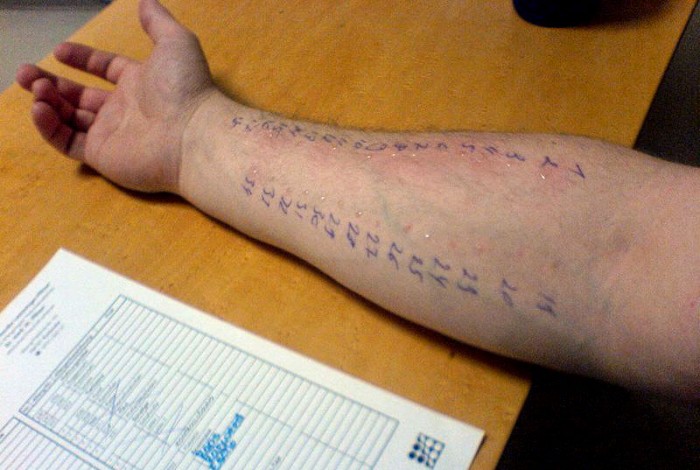Skin tests are one of the most common ways of testing for allergies. They provide quick results and are cheaper than blood tests. The tests involve introducing a tiny amount of a potential allergen to the skin and waiting to see if a reaction occurs, usually in the form of a raised red itchy bump (a wheal) which indicates that an allergy is likely.

Before taking a skin test
If you suspect that you or your child may be suffering from an allergy you should go to see a doctor. Avoid allergy testing offered by non-medical outlets such as health food shops or companies selling self-testing kits over the internet. Your doctor is the best person to decide whether skin testing for allergies is appropriate for you. With a small number of people there is a risk of a severe allergic reaction to the test itself. This is why it is important that any skin testing is done under medical supervision with emergency medication and equipment at hand.
Your doctor will most likely ask you general questions about your symptoms and about your medical history. They might want to know whether any close relatives are allergy sufferers. They will then decide whether skin-testing is suitable.
Various, but not all, antihistamines, indigestion tablets, antidepressants and asthma inhalers might affect the results of skin-prick tests. Some may cause a “false negative”, where the test results indicate that you do not have the allergy, when in fact you do. Some medications increase the risk of a serious reaction to the skin tests. Your doctor might instruct you to stop taking your medication for several days before the test, or they might decide that it would be dangerous for you to stop taking your medication and that blood tests would be more appropriate for you.
What will happen during the test?
The test will usually be done in a doctor’s office or clinic. A nurse usually performs the test and the results are then scrutinized by a doctor. There are three main type of skin test for allergies:
The skin prick / scratch test
A tiny amount of the potential allergen is placed on the skin, usually on the forearm. The area is then pricked or scratched with a needle. This procedure is not really painful. It feels no worse than when someone scratches you with their fingernail. This test can be used to test for as many as 50 allergens at the same time. Any reaction is likely to occur within 20 to 30 minutes.
The intradermal test
In this test the potential allergen is injected under the skin. This test, which is often used to test for allergies to penicillin and to insect venom, is more sensitive than the skin prick test. However it produces more false positive results. Any reaction is likely to occur within 20 to 30 minutes.
The skin patch test
This test is used to test for contact dermatitis. A solution containing the potential allergen, such as latex, hair-dye and certain perfumes, is placed on pads which are then taped to the skin (usually the back) for around 48 hours (sometimes longer).
Is there a risk?
Generally skin tests are very safe as you will only be exposed to tiny amounts of the allergen and, in the rare event that it is necessary, emergency medical attention is immediately available. If you do feel any reaction in any part of your body outside of the immediate area being tested, such as swelling, difficulty breathing or light-headedness, you should inform the practitioner immediately.
The results of a skin test
The results of an allergy skin prick test or intradermal test will usually show up very quickly, often within 15 minutes. This means that in most cases you will be able to discuss the results and an appropriate course of action with your doctor immediately after taking the test. If an allergy has been diagnosed, this will usually mean avoiding the allergen as much as possible, whether through diet or lifestyle change.
Skin tests are not always accurate. Whereas a “false negative” result (suggesting you are not allergic to the substance when in fact you are) is quite rare, a “false positive” result (suggesting that you are allergic to the substance when in fact you are not) is likely in around 50-60% of tests for food allergy. Therefore the results have to be interpreted with care and your doctor may decide to do further investigations to get a better understanding of your condition. Skin tests are more likely to be accurate when testing for allergies to airborne particles such as dust mites, pollen and pet dander.